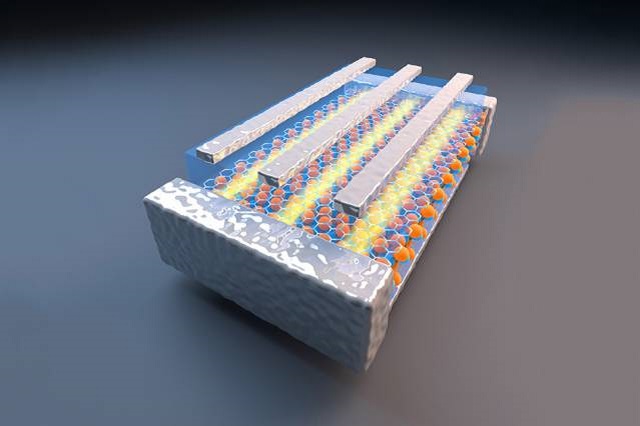 This diagram illustrates the concept behind the MIT team’s vision of a new kind of electronic device based on 2-D materials. The 2-D material is at the middle of a layered “sandwich," with layers of another material, boron nitride, at top and bottom (shown in gray). When an electric field is applied to the material, by way of the rectangular areas at top, it switches the quantum state of the middle layer (yellow areas). The boundaries of these “switched” regions act as perfect quantum wires, potentially leading to new electronic devices with low losses. Illustration: Yan Liang
This diagram illustrates the concept behind the MIT team’s vision of a new kind of electronic device based on 2-D materials. The 2-D material is at the middle of a layered “sandwich," with layers of another material, boron nitride, at top and bottom (shown in gray). When an electric field is applied to the material, by way of the rectangular areas at top, it switches the quantum state of the middle layer (yellow areas). The boundaries of these “switched” regions act as perfect quantum wires, potentially leading to new electronic devices with low losses. Illustration: Yan Liang
Researchers at MIT have demonstrated a new type of two-dimensional material with interesting quantum properties that could lead to the development of the next generation of nanoscale electronics.
The findings published in the Science journal illustrate a class of materials called transition metal dichalcogenides exhibiting the quantum spin Hall (QSH) effect. These materials have a unique ability for conducting electricity at their edges and being insulators in the bulk material.
The researchers have synthesized only two materials with QSH properties as they come across two major drawbacks. The materials, when operating at low temperatures, are incapable of switching on and off rapidly. They also have low bandwidth resulting to a low signal-to-noise ratio.
However, the scientists have discovered a method of using 2D materials to overcome these limitations. One of the researchers explained that the finding is nothing but a true 2D material with QSH properties which is believed to enable new types of low-power quantum electronics and spintronic devices.
Graphene is of high interest when it comes to the research of 2D materials. Few researchers have investigated this material for QSH effects earlier. The transition metal dichalcogenides used in this study are compounds made of thin sheets which are capable of forming a dimerization pattern within its crystals. The QSH effect is a result of this lattice dimerization.
Based on the theoretical effects calculated, the team designed a new transistor called a topological field-effect transistor (TFET). The transistor was constructed with a single layer of the 2D material between two 2D boron nitride layers. It is said that the fabrication of these devices are feasible on a chip at high density, and they possess low losses enabling high-efficiency operation.
The QSH state can be turned on and off with the application of electric field which results in the production of spintronic and electronic devices. The researchers believe that this material is promising in the development of topological quantum computers that do not lose coherence from small perturbations.
Although some of the ideas have been mentioned before, the present system seems especially promising. This exciting result will bridge two very active subfields of condensed matter physics, topological insulators and dichalcogenides.
Nai Phuan Ong, professor of physics at Princeton University
References and Further Reading